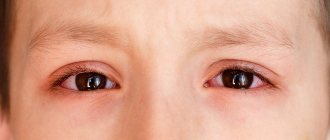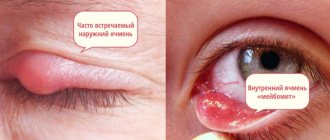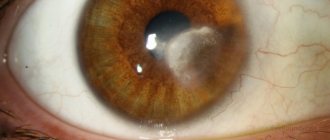Symptoms
With conjunctivitis, specific symptoms occur, namely:
- discomfort in the eye area - burning, itching, pain;
- increased sensitivity to bright light;
- swelling of the organs of vision;
- pinkish tint of the shell;
- swelling of the eyelids;
- discharge of mucous and purulent exudate.
If all of the above phenomena are present, you must stop walking. Uncomfortable symptoms accompany any form of the disease, but they vary:
- viral - itching, burning, lacrimation, redness, swelling of the conjunctiva, mucus discharge, rash of follicles on the lower fold;
- bacterial – pain and sticking of eyelashes, photophobia, lacrimation, the conjunctiva becomes red with bloody streaks;
- epidemic hemorrhagic - hemorrhages throughout the entire eye cavity;
- allergic – lacrimation, itching, swelling, photophobia.
Chlamydial conjunctivitis is accompanied by asymptomatic symptoms, sometimes there is redness of the eyes, photophobia, and lacrimation. 3-5 days after the onset of the disease, pathology of the lymph nodes in the area of the auricles develops. Whether it is possible to go outside with conjunctivitis will be known after diagnosis.
Symptoms
Inflammation of the conjunctiva can be accompanied by various symptoms, depending on the etiology of the disease. The nature of the disease determines not only the symptoms that appear, but also their severity. Let's consider the clinical picture of different forms of conjunctivitis:
Bacterial
Bacterial conjunctivitis is characterized by numerous signs that cause the child discomfort and poor health. In young children, the temperature rises, the eyelids and cheeks swell.
Two eyes are affected, mucosal hyperemia and photophobia are noted, and over time, lacrimation and strong discharge from the organs of vision in the morning begin. Sometimes the baby simply cannot open his eyes after sleep and complains of constant itching and burning. For treatment, the ophthalmologist usually prescribes drops and ointments with antibiotics (Floxal, Tobrex, Ciprofloxacin, Albucid, Tetracycline and Erythromycin ointments)
Causes and types of disease
Each type of eye pathology develops due to the influence of different causes. Factors leading to inflammation.
- Penetration of staphylococci, gonococci, streptococci, viruses or chlamydia into the organs of vision. Pathogenic microorganisms enter the eye by rubbing it with dirty hands, swimming in polluted waters, or using expired mascara, pencils, and eye shadow. Pathogens can also enter the organ of vision through the blood - during infectious diseases (measles, ARVI, chicken pox).
- The allergic type occurs as a response of the body to irritants.
- Infection with chlamydia occurs through water when visiting swimming pools, saunas, and sometimes the disease takes on the character of epidemic outbreaks.
Common reasons:
- regular exposure to irritants: dust, smoke, chemicals;
- influence of ultraviolet rays;
- excessive sensitivity to certain medications;
- non-compliance with the rules for using lenses;
- hypothermia;
- myopia;
- astigmatism;
- farsightedness;
- lack of vitamins.
Often inflammation develops against the background of chronic disease of the nasal and lacrimal ducts.
What is conjunctivitis
The conjunctiva (mucous membrane of the eye) performs important functions. It protects the eye from external influences and moisturizes it. With conjunctivitis, this membrane becomes inflamed. Untimely treatment leads to serious complications: visual impairment, development of dacryocystitis, etc.
The main reasons for the development of the disease:
- allergens (allergic conjunctivitis is the most common form of this disease and is often accompanied by rhinitis);
- viruses (the viral form occurs as a result of individual viruses entering the body: adenovirus and herpes virus);
- bacteria (the development of the bacterial form is often caused by staphylococcus, pneumococcus, etc.).
There are also many additional provoking factors that contribute to the appearance of this unpleasant disease: exposure to chemicals, exposure to UV radiation, smoke, dust, reactions to medications. Also, conjunctivitis can occur against the background of other pathologies (ARVI, influenza), including ophthalmological ones.
Conjunctivitis can occur in acute and chronic forms. In children, the acute form is more common, but another option cannot be ruled out.
The chronic form in pediatric patients begins to develop against the background of vitamin deficiencies or untreated pathologies of the upper respiratory tract (rhinitis, sinusitis). Therefore, you should not self-medicate and at the first symptoms of any respiratory diseases, you should consult a pediatrician for advice.
What is conjunctivitis?
Causes and symptoms
Most often, children develop conjunctivitis due to rubbing their eyes with dirty hands. Parents from the age of 3 need to wean their child from a dangerous habit and teach the rules of hygiene after contact with other people.
The inflammatory process in the mucous membranes of the eyes occurs due to the ingress of pathogens. The most common infections are staphylococcal and streptococcal infections, as well as bacteria. People prone to allergic reactions may develop conjunctivitis due to pollen and other irritants. The disease may go away on its own, but medicinal drops are indicated to speed up the healing process. Pathogens can enter through air, water, and through the use of general hygiene products. There is a high risk of developing an inflammatory disease with frequent exposure to public places, so a child can become infected in kindergarten or school.
Souring eyes and the presence of pus indicate the development of conjunctivitis.
Typical symptoms of conjunctivitis include the following:
- itching and burning;
- acute pain in the eye;
- increased lacrimation;
- discharge of translucent purulent masses;
- foreign body sensation;
- blurred vision.
Disease prevention
To avoid inflammation in the mucous membranes of the eyes, it is necessary to adhere to the rules of hygiene. Prevention of conjunctivitis includes the following procedures:
- Regular hand washing after visiting the street and contacting other people.
- Prohibition on the use of public or other people's hygiene products and cosmetics. This especially applies to towels, mascara, shadows and eye pencils.
- In strong winds and dust, it is recommended to wear glasses.
- To reduce the risk of infection, each family member should have 3 separate towels in the house.
- Before going to bed, for preventive purposes, it is recommended to put compresses on the eyes from soothing herbs - lemon balm, calendula, chamomile.
- If a foreign body gets into the eye, wash with cooled boiled water and apply moisturizing drops. Rubbing mucous membranes with your hands is prohibited.
Is it possible for adults to walk with conjunctivitis?
There is no clear answer to the question of whether it is possible to go outside with conjunctivitis. It all depends on the type of disease, and a number of other factors that we will now consider.
- General condition - if the disease has developed against the background of an acute respiratory viral infection, clinical manifestations of the disease are noted, you should not walk on the street.
- If we are talking about allergic conjunctivitis , then on the street the patient will encounter a new dose of allergens. Then walking will only make the situation worse.
- Time of year and weather conditions. The human eye is sensitive to irritants - wind, sun, dust, cold. And with inflammation, susceptibility increases. In extreme weather conditions, it is better not to go out for a walk. In hot weather, salty sweat can penetrate into the eyes and cause additional irritation and increase discharge. When there is wind, the mucous membrane dries out, and any debris or dust can get into the organ of vision. In extreme cold, the eye becomes hypothermic and the disease worsens.
- It is better to choose a place for walking without the presence of irritating factors: dust, exhaust gases from cars. It is recommended to breathe fresh air in a park, urban forest, or square. Areas full of vegetation will provide protection from excessive sun or wind.
Before the walk, you need to make sure that the body’s condition is normal - there is no fever or intense pain. It is necessary to choose places where the risks of complications are minimal.
Is it possible to walk with conjunctivitis in children in summer and winter, contraindications
Conjunctivitis is the most common eye disease in adults and children.
Usually, inflammation is easily treated and goes away in a few days, but for this you need to follow all the doctor’s recommendations. It is especially important to know whether it is possible to go for a walk if children have conjunctivitis, how to do it correctly and when it is better to stay at home. Depending on the cause and severity of the disease, walking can lead to complications.
In addition, this pathology is often infectious in nature, so a sick child can pose a danger to others.
What is conjunctivitis
Conjunctivitis is an inflammatory eye disease. The conjunctiva, the mucous membrane of the inner surface of the eyelids, is affected. It serves to moisten the eyeball and protect it from adverse external factors. But if it gets infected or irritated, it becomes inflamed.
This disease is common mainly in children, as they often rub their eyes with dirty hands. And the protective forces cannot neutralize the bacteria that have entered the mucous membrane. Due to the weakness of the immune system, it can develop even after a common cold.
Depending on the cause, there are several types of conjunctivitis:
- bacterial occurs due to dirt, sand getting into the eyes, due to the fact that the child rubs them with his hands or wipes them with a dirty handkerchief;
- viral is caused by herpes viruses, adenovirus, rhinovirus, and is transmitted by airborne droplets;
- fungal develops with reduced immunity;
- allergic occurs when the mucous membrane is exposed to fluff, pollen or other allergens.
The disease can be severe or mild, sometimes accompanied only by slight redness of the eyes. But even in this case, it is not always possible to walk with the baby. It is necessary to take into account weather conditions, the presence of wind, dust, precipitation or allergens. These factors can cause the patient's condition to worsen.
Symptoms of the disease in a child
Only allergic conjunctivitis manifests itself almost immediately when the pathogen enters the mucous membrane of the eye. With the bacterial and viral form, it usually takes 5-10 days before the first symptoms appear. In any form, the disease in a child manifests itself with the following symptoms:
- redness of the eyes;
- lacrimation;
- photophobia;
- swelling of the eyelids;
- itching
With bacterial conjunctivitis, signs of purulent inflammation also appear. Pus accumulates in the corners of the eyes, on the eyelashes. There is especially a lot of it in the mornings, it’s even difficult for a child to open his eyes. Sometimes the temperature rises.
The viral form of the disease is accompanied by a runny nose, coughing, and sneezing. The temperature rises and a headache appears. If the cause is the herpes virus, blistering rashes are noticeable on the eyelids and lips. Allergic conjunctivitis is always accompanied by burning and severe itching. Watery eyes, runny nose, and sneezing occur. If you rub your eyes, they turn red and begin to hurt.
The question of whether it is possible to walk with a child with this disease must be decided individually, depending on the patient’s condition.
Of course, you can’t go outside if you have a fever, headache, or a bad runny nose. If you have allergic conjunctivitis, it is not recommended to walk in windy conditions or in places where plants accumulate.
In addition, you should not leave home for a long time, as you need to frequently wash your eyes and drip medications.
Is it possible to walk with conjunctivitis?
Walking is allowed only if the child does not have a fever or weakness. It is advisable to wait a few days until his condition improves.
For walks, it is better to choose a quiet, peaceful place away from dusty roads. For any form of the disease, except allergic, it is best to walk in a park, square or forest.
It is recommended to go outside in the morning or evening when there is no bright sunlight. But you shouldn’t walk late in the evening, the child will get tired and his eyes will water more. It is better to take babies out in a stroller during quiet times.
In what weather is it possible and in what weather is it not worth it?
If you have conjunctivitis, you must protect your eyes from any irritating influences. Therefore, when going for a walk, you need to look at the weather. You can’t go out if it’s raining, even lightly.
Wind is contraindicated for a sick child, as it carries dust, pollen, and small debris. The last thing to avoid is sunlight. Therefore, it is recommended to walk only in calm weather, preferably cloudy.
Is it possible to walk with conjunctivitis in summer and winter?
It is especially difficult to refrain from walking in the summer. When the weather is warm and good, even sick children want to go outside. And conjunctivitis rarely leads to a significant deterioration in the general condition. Therefore, it is difficult to keep a child at home in the summer. But while walking, you need to take into account the impact of adverse factors that can harm sore eyes:
- bright sunlight causes irritation, lacrimation, and can lead to increased inflammation;
- even on a cloudy summer day it can be hot, but you need to make sure that the child does not sweat, as sweat getting into the eyes will cause increased itching;
- It is not advisable to walk in strong winds, as it can bring dust, sand or pollen into the baby’s eyes.
In winter there are more favorable conditions for walking. The main thing is to protect your eyes from sunlight, since when reflected from the snow, it can be even brighter than in summer. It is also unacceptable to overcool.
Therefore, it is recommended to walk at temperatures not lower than -100. Frost leads to watery eyes and thickening of pus.
And with viral conjunctivitis, hypothermia will lead to worsening runny nose and the appearance of new rashes.
How to dress a child
When going for a walk, you need to dress your child according to the season. It is not recommended to bundle him up, but a hat and scarf are required in cold weather. It is advisable to wear a cap with a visor, which will help protect your eyes from light, wind and precipitation.
In the summer, a Panama hat is a must. And in bright sunshine, either don’t walk at all, or put dark glasses on the child, since with conjunctivitis the eyes are very sensitive to light.
If the disease is caused by allergies, it is not advisable to wear woolen items or clothes made of synthetic materials, which can cause increased irritation.
Walking for different types of conjunctivitis
Before deciding whether or not to go for a walk with your child, you need to take into account the type of disease.
- With bacterial conjunctivitis, you can go outside only after a few days, when the child’s condition improves. In this case, you need to make sure that there is no wind or rain, so that the baby does not rub his eyes with his hands. If he is walking on the playground, it is advisable to limit his communication with other children. He can infect them, in addition, they can accidentally get into his eye with sand, a ball or his hand.
- Viral conjunctivitis is very contagious, so you can only walk separately from other children. If the baby does not have severe watery eyes, runny nose or itching, you need to walk with him along quiet streets or go to the park. The main thing is to ensure that your eyes are not exposed to sunlight, wind, or rain.
- If conjunctivitis is allergic, you can only walk away from places where plants accumulate. The disease can be caused by pollen from dandelions, fruit trees, and poplar fluff, so in the spring it is unsafe for the patient even in the city. It is better not to go outside if your child is itchy, as scratching his eyes can cause an infection.
In what cases are walks contraindicated?
Walking in the fresh air is good for your health. But with conjunctivitis, they can cause harm and worsen the child’s condition. Doctors do not recommend taking your baby outside if he has bacterial conjunctivitis that affects both eyes.
Usually this causes severe lacrimation, itching, and swelling. The released pus sticks the eyelashes together, so they need to be washed frequently. Any dust or sand that gets into the eyes will worsen the symptoms.
Doctors also do not recommend walking if you have viral conjunctivitis, which is contagious. The child must be isolated from other children, as the disease is transmitted by airborne droplets. And if the pathology occurs due to exposure to pollen or plant fluff, going outside is contraindicated.
Also, for any form of the disease, there are cases when doctors do not recommend walking with the child:
- the bright sun is shining, to which the patient’s eyes are very sensitive;
- a strong wind blows, it can bring dust and sand into your eyes;
- it is raining or snowing;
- air temperature below -100.
Possible complications
If you do not follow the doctor’s recommendations and take your sick child outside, complications may develop. A mild viral or allergic form can be complicated by a bacterial infection.
Due to the fact that the child rubs the eyes, it spreads to other tissues. Keratitis, uveitis, and blepharitis develop. Such pathologies can lead to vision loss.
Advice from pediatricians
Pediatric doctors recommend keeping the child at home for a couple of days after the onset of the disease. If there is no deterioration in the condition, you can go for a walk with him. The main thing is to protect your eyes from the sun, wind, dust and precipitation. In addition, with bacterial and viral forms, it is necessary to limit the patient’s communication with other people.
If conjunctivitis is allergic, doctors recommend avoiding exposure to allergens. Usually such a reaction is caused by one factor: pollen, dust, car exhaust. Therefore, you need to walk where there are no these allergens.
Doctors recommend teaching your child not to rub his eyes and to follow the rules of hygiene. The baby must have his own towel. He cannot watch TV for a long time, sit in front of the computer, or play on the phone. This leads to eye strain and reduces their protective functions.
Many parents consider conjunctivitis to be a non-serious disease. But without proper treatment and following doctor's recommendations, it can lead to complications. A child's eyes are very vulnerable, so in order to preserve his vision, it is better not to walk with him for several days until the condition improves.
about conjunctivitis in children:
Select it and press Ctrl+Enter to let us know.
Source: https://glaza.online/zabol/kon/mozhno-li-gulyat-pri-konyunktivite-u-detej.html
What to do before your walk
If a person has conjunctivitis, before going outside it is recommended to follow the following rules:
- determine weather conditions, whether there is precipitation or strong wind, during which the clinical symptoms of the disease worsen;
- use medications prescribed by a doctor (antibiotics, antivirals, fungicides, antihistamines);
- perform superficial eye hygiene using antiseptic solutions or running clean water;
- if pus is released abundantly in the eyes, you should wash it off with clean water or Furacilin, and drip an antibiotic;
- take sunglasses with you that will protect not only from the bright sun, but also from strong winds;
- Take with you wet wipes that can be used to clean your eyes if pus is discharged.
The patient should remember that when sick, walks should be shorter. It is recommended to avoid public places with large crowds of people to avoid spreading the infection among them. If weather conditions change sharply, your health will worsen and copious amounts of pus will be released. He should return home so as not to worsen his body's condition.
Is it possible to go to school or kindergarten?
It is recommended to limit the child’s communication with other children and adults.
The school nurse may not allow the child to enter the educational institution, since the infectious form of the disease is transmitted by airborne droplets. To avoid infecting other students, one of the parents is recommended to take sick leave, because conjunctivitis occurs within 2 weeks. Contact with other people and visiting public places must be minimized, because the body’s defense system is weakened and inflammation may increase. Exposure to high and low temperatures and high humidity is especially dangerous. If one of the family members is infected, then he should communicate with the child as little as possible until recovery.
With colds, treatment of conjunctivitis takes longer. There is also a weakening of the body's immune defense.
If there is an urgent need to leave the apartment, the child must put Albucid, Balarpan, Taufon or Levomycetin in his eyes. If it is raining or strong wind outside, the walk should be postponed. It is especially dangerous to be exposed to open sunlight in winter when there is a lot of snow. Applying a bandage to an injured eye is contraindicated. If you have an allergic form of the disease, you should not wear woolen clothes. In the evening before going to bed, it is recommended to put cooled green or white tea lotions for 5-10 minutes.
Is it possible for children to go outside with conjunctivitis?
Children are more likely to encounter various diseases due to imperfections in the body's protective functions. Clinical signs of any disease are felt more intensely than in adults, the same applies to conjunctivitis. Before you go out with your child, you should consider the following factors.
- Older children become infected through contact with pathogenic agents on the mucous membrane of the eye. Most often they come from unwashed hands, when using common household items. Spending time together leads to the fact that a sick child infects another. This should be taken into account before taking him outside.
- If damage to the conjunctiva has developed due to a respiratory viral or bacterial infection, walking on the street is not recommended. These forms of the disease are the most contagious; it is especially dangerous to walk during the acute phase of the pathology. If you have an allergic inflammation, you can go out and get some air. It all depends on how you feel, the presence of a concomitant illness in the form of a cold, ARVI.
- When a child is diagnosed with conjunctivitis, is it possible to walk outside in winter? No, you shouldn't do this. Going out for a walk with a patient in the cold is dangerous due to hypothermia of the eyes, aggravating the course of the pathology. In the hot season, the mucous membranes of the visual organs are exposed to the sun, and the child can rub them with dirty hands. Infectious agents multiply faster when exposed to high temperatures. In the off-season, as well as in winter and summer, in normal weather and satisfactory health, you can walk for no longer than 1 hour.
When the illness does not cause discomfort to the baby, you should not protect him from being in the fresh air. If the disease is accompanied only by redness of the eyes, you can walk. If there is a bacterial or viral form, contact with other children should not be allowed. When the eye disease is of an allergic nature, it is worth walking with the child in a place that is safest in terms of the presence of allergens.
Read in a separate article: What is conjunctivitis: types, signs and how to treat it
Treatment of bacterial conjunctivitis in children
If tests confirm the diagnosis of bacterial conjunctivitis, the child will most likely need treatment with antibacterial drugs. Typically, this disease develops due to the contact of various bacteria with the mucous membrane of the eye. The most aggressive of them are staphylococcal, streptococcal and pneumococcal. A child can “addict” these unpleasant “tenants” with the help of dirty hands. Also, microorganisms appear as a result of an existing disease - for example, tonsillitis, purulent otitis or sinusitis.
Treatment of bacterial conjunctivitis involves rinsing with special sterile solutions and applying antibacterial ointments. In difficult cases, the doctor may prescribe antibiotics.
How to deal with allergic conjunctivitis
As for conjunctivitis of the allergic form, here first of all you need to eliminate the irritant. If you do not know about the true factors that cause such a reaction in the body, take note of a few simple recommendations. For conjunctivitis, they will come in handy:
- Constantly monitor your child’s diet: it should only be hypoallergenic.
- It is extremely important that there is no dust in the room. Every day, wet clean the room, remove carpets, soft toys, feather pillows and other “dust collectors” away.
- Say no to chemistry! At least during the period of your baby’s illness, limit the use of aggressive detergents, dyes, fragrances, etc. in the house.
- Try to give your pets (if you have any) to relatives or friends for a while, because pet hair can cause allergies.
Popular drugs for conjunctivitis in children and adults
With proper and timely therapy, inflammation of the conjunctiva is eliminated in 5-10 days, the chronic form - in 4-5 weeks. The treatment regimen depends on the specific type of disease.
Treatment of various types of diseases in adults.
- Bacterial conjunctivitis in acute form is eliminated with drops (Albucid 30% and levomecitin 0.25%) and ointment (tetracycline 1%). Before dripping the medicine, you need to rinse the visual organs with an antiseptic solution. Chamomile decoction and tea leaves are suitable.
- The viral type is treated with Interferon in the form of drops, antiviral ointments - Florenal, Bonafton, Tebrofen, Oxolin. Use the products 3-4 times a day.
- Conjunctivitis of allergic etiology is eliminated with the help of oral antihistamines - Cetrin, Zyrtec, Claritin. Drops from a range of membrane stabilizing agents
- With conjunctivitis of a bacterial nature , pus is released from the eyes, the eyelids stick together, and it is difficult to lift them. To soften the hardened exudate, you should rinse them with warm chamomile infusion.
Therapeutic scheme for combating eye disease in children.
- In case of a viral or bacterial form , Albucid is dripped into the eyes, regardless of the child’s age. Every 2 hours, wash them with chamomile or furatsilin solution. Apply tetracycline and erythromycin ointment to the visual organs.
- In case of an allergic type of disease, they resort to anti-allergic drugs - Zodak, Zyrtec.
Treatment of viral conjunctivitis in children
The viral form of the disease usually manifests itself against the background of acute respiratory infections, measles, herpes, and varicella (chickenpox). In this case, the symptoms are supplemented by a runny nose, sore or sore throat, rash and other signs of the underlying disease. Treatment of viral conjunctivitis in children consists of fighting the underlying disease and strengthening the immune system.
Treatment of eye conjunctivitis in children with a professional ophthalmologist will not take much time. Advanced forms of the disease can go into a chronic stage and significantly complicate the child’s life, leading to myopia or farsightedness, constant swelling and the appearance of abscesses. Don't risk your child's health! Contact the specialists of the Children's Medical Center "Human Health" in a timely manner to quickly and effectively get rid of the disease.
Viral type of disease, therapy and drugs
Before treating conjunctivitis in a child, the doctor must be sure of the etiology of the disease. Therapy for the viral form of pathology is fundamentally different from that described above. In this case, the mandatory use of local antiviral drugs and interferon-based immunomodulators is required. The following eye drops and ointments with active antiviral components have the least contraindications for children:
A child with viral conjunctivitis cannot attend kindergarten or school for the same reason as with bacterial conjunctivitis - because of the likelihood of infecting other children.
Is it allowed to leave the house?
Doctors advise minimizing the child’s contact with peers until complete recovery.
If a child has conjunctivitis, then doctors do not recommend walking on the street, and also advise minimizing his contacts with peers and the environment. Despite the benefits of fresh air and the need to saturate tissues with oxygen, the influence of external factors can worsen the disease. The optimal solution is to regularly ventilate the room when the child is in another room.
It is especially not recommended to go outside if you have viral conjunctivitis, as there is a high risk of the infection spreading quickly, which will lead to infection of other people. In case of allergic etiology of eye diseases, the source of the acute reaction of the body must be accurately determined. Since pollen and certain plants are most often allergens, going outside during the flowering period is contraindicated. The newborn is recommended to stay at home or on the hospital premises for 5-7 days, during which the disease usually resolves completely, if the mother has not yet been discharged.
You can walk with your child in the fresh air for no longer than 10-15 minutes, especially with a baby. Being outdoors can cause particles of dust and dirt to enter the mucous membranes of the eye, which will intensify the inflammatory process. Increased humidity, wind and other physical factors will negatively affect the condition of the visual organ. Doctors especially do not recommend walking outside in bad weather conditions, which are often observed in the fall.
Basic information about the disease
In ophthalmological practice, childhood conjunctivitis occurs quite often and in most cases is transmitted through dirty hands. If detected early and treated correctly, it does not pose a threat to the child’s health and does not affect visual acuity. But after the first symptoms appear, you should not delay visiting a specialist, since in children the disease develops rapidly.
There are three main types of inflammatory process:
- Viral - in most cases it appears during infection with respiratory diseases, influenza, and other diseases caused by viruses. The pathology is accompanied by general malaise, possibly fever, cough, and rhinitis. The main symptom is tearing, redness, and the release of mucous fluid.
- Bacterial - provoked by bacteria that enter the child’s body from dirty hands, as well as household items (for example, through towels). A distinctive feature of this variety is the appearance of purulent masses, due to which the eyelids stick together. May only affect one eye.
- Allergic - occurs after a child comes into contact with irritants, which can be plant pollen, house dust, animal hair, food and much more. In this case, the eyelids become very swollen, red, and profuse lacrimation appears. The allergic variety affects both eyes at once.
On average, the disease lasts from 5 to 10 days, during which the baby needs to regularly wash his eyes with antiseptic solutions, instill medicinal drops and apply ointments. An integrated approach will allow you to get rid of the problem in the shortest possible time.
When can you go for a walk?
After 2-3 days the severity of the disease noticeably , discharge on the eyelashes after sleep still remains, but the eyelids no longer itch so much.
Naturally, the child’s mood is restored and he begins to be drawn to the street.
If vision is not impaired and the disease is not contagious, then walking will only benefit both adults and children.
A child is allowed to go for walks only when he has a mild form of conjunctivitis , but under strict conditions of caution and the exclusion of any contact with other children.
In any case, the patient’s condition must be assessed by an appropriate specialist, and loving parents should always remember the weather, time and place suitable for walking.
It is worth noting! Spring pollen is a fairly strong allergen, and with a weakened immune system, there is a serious risk of developing allergies and worsening the condition.
But in many cases this is not a reason to stay at home, the only exception being connections with other children, since they are more susceptible to negative factors than others.
Is it possible for a child with conjunctivitis to walk outside?
Conjunctivitis is an eye disease that develops in people of different age categories, mainly in winter, spring and autumn.
In children, conjunctivitis is diagnosed more often, so parents are concerned about the following questions: how to help their child cope with the disease, what conditions will be most comfortable during this period, is it possible to walk with conjunctivitis in children.
To answer them, we must first understand in more detail the nature of this phenomenon.
How does the disease manifest itself?
Many people have experienced the unpleasant symptoms that appear with conjunctivitis at least once in their lives. Swelling of the eyelids, redness of the eyes, tearing, photophobia are the main manifestations of the disease. It seems that everything is familiar and understandable, but you can’t do without visiting a specialist, since similar symptoms can accompany other ophthalmological pathologies.
With conjunctivitis, it is very important to determine the nature of the disease. With different forms of pathology, the symptoms are somewhat different. For example, with allergic conjunctivitis, in addition to the above manifestations, others may occur. The child may experience additional discomfort in the form of itching and burning in the affected area, cough, hyperthermia and runny nose.
With the viral form, only one eye is most often affected (with the bacterial form, as a rule, both eyes are affected). Other features of the course of viral conjunctivitis: enlarged lymph nodes, spread of infection to the cornea.
The bacterial form is more complex and takes longer. The child feels the presence of a foreign body, copious discharge appears, including purulent discharge, even during sleep (the eyes “stick together” and are difficult to open in the morning). This form is contagious (this also applies to viral conjunctivitis), so it is necessary to observe the rules of personal hygiene.
Treatment of bacterial conjunctivitis is carried out using antibacterial drugs; viral - with the help of drugs that eliminate the virus that caused the disease; allergic – with the help of antihistamines. Therefore, only a doctor can quickly and competently help a child.
Walking with conjunctivitis
With ARVI, a child can go for a walk if he is active, bears the disease cheerfully and there is no hyperthermia. This recommendation is known to almost every parent. But what about conjunctivitis? In what cases is it possible and even necessary to go outside, and in what cases is it better to stay at home?
What weather can you go for a walk in?
With this disease, the weather plays an important role when deciding on walks. Naturally, a child can go outside only if he does not have a fever and has enough strength and energy. The general condition must be satisfactory.
According to the recommendations of experts, you can take a walk if you are outside:
- calm, not windy weather (to avoid foreign particles getting into the eyes: sand, dust, etc.);
- it doesn't rain or snow;
- not too hot (in the heat, the child sweats and salty liquid getting into the eyes and the area around them causes itching and burning);
- not too cold (frost can cause lacrimation and thickening of purulent exudate);
- not the bright scorching sun and not pitch darkness (in such conditions the child’s eyes are strained, which is extremely undesirable for conjunctivitis).
In summer, it is best to go outside with babies in the morning or evening. It is especially good if the child is sleeping at this moment. The location where the walk will take place also matters.
Children with viral and bacterial conjunctivitis should play separately from other children to avoid exposing them to the risk of infection. Therefore, playgrounds should be abandoned during illness.
An ideal place for walking and playing is a square, park, alley.
The child must be dressed appropriately for the weather. He should not sweat and he should not be cold. This is the basic rule that parents must learn when going for a walk at any time of the year.
When you can't go for a walk
Before deciding to go for a walk, you should take into account a number of factors: the stage of the disease, the etiology of the disease, season and weather conditions, and the child’s well-being.
If a child has chills, feels unwell, or has a fever, then going for a walk is out of the question. It must be provided with comfortable conditions.
Eliminate bright light in the room, carry out timed procedures (eye drops, lotions, etc.), protect from negative emotions, give enough fluids and entertain.
All that is required from parents in this condition is care.
It is also very important to consider the nature of conjunctivitis.
If the disease arose as a result of an allergic reaction to pollen, flowering and other factors, from which the situation can only worsen during a walk, then of course it is better to stay at home during this period.
You should not go outside unless you can avoid contact with other children. In this case, the child, isolated from the children’s company, will feel constant discomfort and will not receive any benefit from the walk.
To prevent the development of conjunctivitis, it is necessary to strengthen the child’s immunity. He must eat right, spend enough time in the fresh air, and do exercises. It is also very important to ensure that the child adheres to the rules of personal hygiene (constantly wash his hands after going outside and before eating).
A special role is played by the timely response of parents to diseases. Conjunctivitis, especially in infants, should be treated from the first days of symptoms. The same applies to respiratory diseases, since even an advanced form of rhinitis can provoke the development of conjunctivitis and other diseases that are no less difficult for a child.
Source: https://oculistic.ru/bolezni/konyunktivit/mozhno-li-detyam-pri-konyunktivite-gulyat-na-ulitse
How to suspect a disease
Inflammation in children develops rapidly, causing a lot of unpleasant sensations, which is why the baby’s well-being deteriorates sharply. The main symptoms are:
- Severe redness of the entire eye, resulting from an increase in the size of the vessels. With the viral and allergic form, redness is observed in both eyes, and with the bacterial form, in one.
- Sensation of a foreign body, grains of sand in the eye, which is why children constantly scratch their eyes, trying to remove the interfering object. Due to constant rubbing, the mucous membrane becomes even more inflamed, increasing the risk of secondary infection.
- Profuse lacrimation, in which the secreted liquid is light and odorless. If pus is noticed, this indicates a bacterial infection!
- Swelling of the eyelids, which makes it difficult for the child to open the eyes, and in severe cases they may be closed until the condition improves.
- A burning sensation in the eyelids, which may be accompanied by a cutting pain when moving the eyes.
- Photophobia - the baby closes his eyes when in bright light, prefers to be in a dark place.
- An increase in the size of the papillae of the upper eyelid or follicles located on the lower eyelid.
The baby becomes restless, capricious, lethargic, and may refuse food and favorite activities. If any symptoms appear, you should seek help from a pediatric ophthalmologist as soon as possible!
What should you pay attention to before leaving home?
Categorical contraindications
In bright sunlight, the child may experience increased pain.
You can walk outside only after first assessing the condition of the child or infant. In case of acute inflammation, elevated temperature and redness of the eye, walking is prohibited. Also, if you have concomitant diseases that weaken your immune defense, you should stay home. The parent needs to evaluate the following environmental factors presented in the table:
| External circumstances | Dangerous consequences |
| Bright sunshine | Increased pain |
| Wind | Irritation of the mucous membranes of the eye |
| Increased inflammation | |
| Introduction of a foreign object | |
| Rain | |
| Spread of infection | |
| Low temperatures | Increased tear production |
| Flowering period of plants | Increased allergic reaction |
| The appearance of redness of the skin |
Basic recommendations
In winter, at very low temperatures, if the child has weak blood vessels, intraocular hemorrhage may occur with conjunctivitis. The most dangerous consequence is chronic visual impairment.
Doctors advise carefully selecting clothes for walking, depending on weather conditions.
If going outside cannot be avoided, then parents should adhere to the following advice from doctors:
- Hypothermia and overheating of the body are equally dangerous. Clothing should be selected from natural materials, however, in case of allergic etiology of the disease, woolen products are contraindicated.
- In sunny weather, the child should wear a cap or sunglasses. It is important to consider that in winter the sun's rays reflect off the snow and increase the negative impact on the eyes. It is prohibited to use bandages or cover the injured eye with gauze discs.
- You should walk away from highways and factories. Exhausts and harmful substances will increase inflammation and provoke the release of purulent masses. Preference should be given to parks.
- In spring, you need to eat a lot of fruits and vegetables to strengthen your immune defense. The therapist may additionally prescribe vitamins.
- The child should be warned not to rub the organs of vision with their hands, even if there is a feeling that a foreign object has entered the eyeball. You also need to explain that you cannot avoid touching other children’s toys and clothes.
- The optimal time for walking with a baby is after sleep at lunchtime, and with a child over 3 years old - in the evening. However, if you are very tired, it is recommended to stay at home.
Before and after visiting the street, doctors recommend instilling medications prescribed by the ophthalmologist. The most common are Oftadek, Albucid, Tobrex and Floxal. Before going to bed, apply erythromycin or tetracycline ointment under the eyelid. Folk remedies will help by wiping the mucous membranes of the eyes and eyelids with cooled black tea. If the inflammatory process intensifies and acute pain occurs after walking in the fresh air, you should immediately consult an ophthalmologist.











